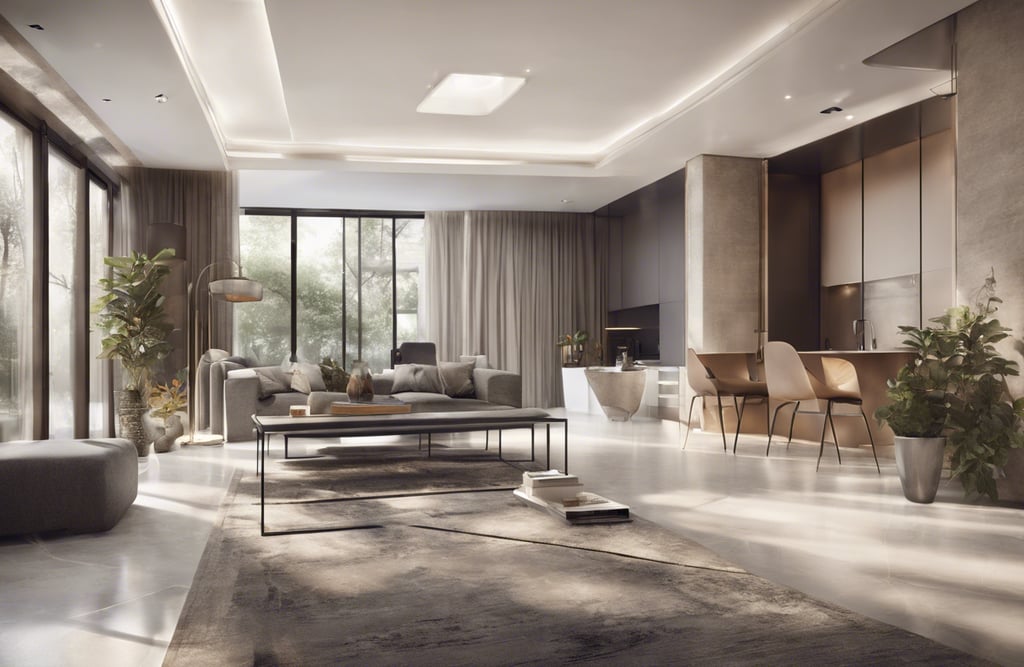Photorealistic 3D rendering: Everything You Should Know in 2024
Roman Marchyshak
9/3/20246 min read


Photorealistic 3D rendering: Everything You Should Know in 2024
Key Takeaways:
Growing Significance of Photorealistic 3D Rendering: In 2024, photorealistic 3D rendering is becoming ever more crucial across various industries, enhancing visual storytelling and providing a true-to-life portrayal of concepts and designs.
Mastering Photorealistic Techniques: Essential techniques like using IES light profiles for accurate lighting, beveling and chamfering for refined edges, texture-mapping, and HDRI lighting are critical in achieving lifelike effects in 3D renders.
Crafting Realistic 3D Interior Renders: Achieving photorealism in 3D interior renders requires precise scale adjustment, sophisticated lighting techniques, the use of PBR (Physically Based Rendering) materials, and meticulous attention to scene setup and texture consistency.
The Value of 3D Photorealism: Photorealistic 3D renders greatly enhance visual communication, offering a convincing and engaging representation of ideas and designs that effectively bridge the gap between imagination and reality.
The Role of Professional Software: Professional 3D rendering software equips artists with tools for managing depth of field, lighting, and textures, enabling the creation of top-quality, photorealistic 3D renders.
In an era increasingly dominated by digital technologies, the growth and importance of 3D rendering—particularly photorealistic rendering—are becoming more apparent. This technology has revolutionized industries like architecture, gaming, and advertising by improving visual communication and offering a realistic preview of concepts and designs. Photorealistic rendering, in particular, blurs the line between the virtual and real worlds, providing an experience that can greatly influence decision-making processes.
However, as photorealistic rendering continues to evolve, so does the need for optimization. As demand for these realistic renders increases, so too does the necessity for solutions that meet specific needs. By acknowledging this, we can harness the full potential of photorealistic 3D rendering, tailoring it to suit individual requirements, ensuring efficiency, and driving the evolution of this indispensable technology. The future of 3D visualization is not only about understanding photorealistic rendering but also about optimizing and adapting it to our specific needs for maximum impact.
Understanding the Basics of 3D Rendering:
3D visualization is a powerful tool that allows us to create detailed, lifelike images that simulate real-world scenarios. Essentially, it involves transforming three-dimensional models into 2D images or animations using computer graphics. This technique is invaluable across industries like real estate marketing, gaming, and interior design.
Rendering is a critical phase in the 3D visualization process, where a basic model is transformed into a detailed, sophisticated image that resembles real life. The value of photorealistic renders is clear—they enable designers to replicate natural lighting, textures, and colors with exceptional accuracy. With the right lighting setup, including basic illumination configurations, photorealistic renders can be so lifelike that they are nearly indistinguishable from actual photographs.
The field of 3D rendering has advanced significantly, with CGI technology playing a key role in producing photorealistic renders that offer a new level of realism. This technology is widely used by interior designers to visualize spaces and materials with high precision. The benefit is clear—clients can see exactly how a space will appear, down to the smallest details, before any physical work begins.
Presentations, exhibitions, and various industry applications benefit greatly from 3D rendering. For example, real estate marketing uses this technology to create immersive property tours that engage potential buyers more effectively than traditional methods. By combining 3D rendering with photorealism, digital creations come to life, offering viewers an experience that closely mirrors reality.
Breaking Down Realistic 3D Rendering:
Photorealistic 3D rendering aims to produce images so realistic that they could be mistaken for photographs. Achieving this level of realism involves using specific software, techniques, and a robust rendering engine. The process resembles real-life photography, where an object is viewed from various angles and illuminated with different light profiles to create the most realistic image possible.
Key components of achieving photorealism include the use of high poly models, photometric lighting, IES light profiles, and precise texture mapping. These elements are integrated within the rendering engine using the right software to produce high-quality images that faithfully represent the final design. Post-production techniques can further enhance the exterior renderings, making them virtually indistinguishable from real-life photos.
Photorealistic 3D rendering is immensely valuable in today’s world, especially in fields like real estate, where agents can provide prospective buyers with lifelike images of properties even before construction begins. This level of detail aids both marketing efforts and decision-making processes.
In interior and product design, photorealistic 3D rendering allows designers to explore and showcase their work in unparalleled detail. By viewing designs from multiple angles and under varying light profiles, designers can perfect their creations before final production.
Overall, photorealistic 3D rendering is transforming how we visualize concepts, turning virtual designs into reality and driving innovation across multiple sectors.
Mastering Techniques to Improve Photorealism in 3D Renders:
Mastering photorealistic 3D rendering techniques is crucial in the design process. Techniques like using IES light profiles for photometric lighting, beveling and chamfering for more natural edges, texture-mapping, and utilizing HDRI lighting for global illumination all contribute to creating lifelike renders.
IES light profiles are especially useful for producing realistic lighting effects that significantly enhance the final image. Beveling and chamfering help create more natural, realistic edges, adding depth and authenticity to high poly models and other elements within the 3D scene.
Other essential techniques include texture mapping, depth of field manipulation, chromatic aberration, and asymmetry, each adding its dimension of realism. Texture mapping brings surfaces to life, while chromatic aberration introduces subtle yet dramatic effects that enhance photorealism. Incorporating natural imperfections and asymmetry makes the scene more relatable, fostering an emotional connection with potential clients—a crucial aspect of successful marketing strategies.
Specular maps are another vital tool for 3D artists, allowing them to highlight and diffuse certain areas of the model, simulating how light interacts with different surfaces. For example, they can make glossy pages of furniture catalogs look incredibly lifelike in a 3D render.
Finally, refining the final image and avoiding common mistakes are crucial for achieving the perfect shot. This may involve adjusting V-Ray settings, fine-tuning the lighting, or adding minor imperfections to enhance realism.
Mastering these techniques can elevate architectural presentations and product designs, offering a level of detail that allows viewers to fully visualize the final product, thereby increasing their overall engagement and investment.
Crafting Photorealistic 3D Interior Renders:
Creating photorealistic 3D interior renders is a complex process that requires a deep understanding of various techniques, the right software, and an eye for detail. The journey begins with the creation of a 3D model, where the initial work takes place.
The first step is ensuring accurate scale adjustments. Proper proportions are essential for creating a believable interior. Precise 3D modeling, including furniture and decor, contributes to creating a realistic and immersive experience for viewers.
Lighting is another critical element in 3D rendering. Applying depth of field, managing shadows, and effectively using global illumination can greatly enhance the photorealism of the scene. Different lighting techniques, such as IES light profiles or HDRIs, can provide a higher level of realism.
The quality of materials also plays a significant role. PBR materials, or Physically Based Rendering materials, allow for the creation of surfaces that closely mimic real-world counterparts, further enhancing the realism of the render.
Scene setup and texture consistency are vital. Every detail matters, from the placement of objects to the coordination of textures. Attention to these details, combined with the use of popular software like 3ds Max, Blender, or V-Ray, can significantly improve the final result.
The final touches occur in post-production, where color correction, brightness and contrast adjustments, and the addition of elements like depth of field enhance the photorealistic effect.
3D renderings have revolutionized industries such as product design and real estate. They allow for detailed visual presentations before any physical work begins, making photorealism important not just for aesthetics but also as a practical visualization tool.
In conclusion, achieving photorealistic 3D interior renders requires a collective effort, mastery of various techniques, and the right software. The results are well worth the effort, offering a level of realism that captivates and convinces viewers.
Conclusion:
The importance of 3D rendering in various industries, especially real estate and product design, is undeniable. Detailed 3D renders offer a powerful visual communication tool, streamlining interactions with stakeholders, clients, and team members. They enable complex ideas and designs to be presented accurately and convincingly, bridging the gap between imagination and reality.
The value of 3D photorealism is immense. As the culmination of intricate 3D modeling and precise rendering techniques, photorealistic renders provide a view that closely mirrors reality, allowing viewers to visualize 3D models in a tangible and authentic way. This realism not only makes projects more aesthetically pleasing but also more credible and trustworthy.
Using professional software is essential for achieving high-quality results. These tools allow 3D professionals to control depth of field, manage lighting, and create textures that make the render appear as though it was taken from the real world.
3D photorealistic rendering is a valuable asset in the modern design and visualization landscape. It enables more accurate, compelling, and efficient presentations of ideas, enhancing the skills and output of 3D visualizers. The numerous benefits it offers make it a worthwhile investment for any business aiming to improve its visual communication.
